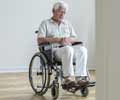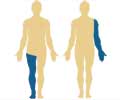The study was initiated by the Christopher & Dana Reeve Foundation and conducted by the University of New Mexico's Center for Development and Disability. More than 30 experts from 14 leading universities and medical centers and the U.S. Centers for Disease Control and Prevention set the parameters for the survey. The development of the survey, acquisition and analysis of the data took over three years.
"This is the first population-based survey to measure the national prevalence of paralysis," said Anthony Cahill, Ph.D., principal investigator for the study and Director of the Division of Disability and Health Policy in the Center for Development and Disability at the University of New Mexico's School of Medicine. "The enormous data set offers a wealth of information about this population."- Paralysis is dramatically more widespread than previously thought. Approximately 1.9 percent of the U.S. population, or 5,596,000 people reported they were living with some form of paralysis, defined by the study as a central nervous system disorder resulting in difficulty or inability to move the upper or lower extremities. This is about 40 percent more Americans living with paralysis than previously estimated (~four million).
- Spinal cord injury is also more prevalent than previously estimated. Data indicate that 1,275,000 people in the United States are living with spinal cord injury-more than five times the number of Americans previously estimated in 2008 (255,702).
- We are more certain about causes of paralysis. The leading cause of paralysis was stroke (29 percent), followed by spinal cord injury (23 percent) and multiple sclerosis (17 percent).
- Paralysis appears to be disproportionately distributed among some minority communities, such as African Americans and Native Americans, but not all. Hispanics who are living with paralysis represent approximately the same percentage as those who report being Hispanic in the United States census.
- People living with paralysis have households with lower incomes. Household income for those with paralysis is heavily skewed towards lower-income brackets and is significantly lower than household income for the country as a whole. Roughly 25 percent of households with a person who is paralyzed earn less than $10,000 per year, compared with only seven percent of households in the general population.
Advertisement
"This study reveals important findings about the prevalence of paralysis and spinal cord injury, but we must also remember that behind each of these statistics are real people, who along with the rest of their families are facing urgent needs," says Dr. Edwin Trevathan, Director of the CDC's National Center on Birth Defects and Developmental Disabilities. "This is a crucial first step to providing appropriate public health supports for this community in understanding how many people live with the condition, who they are, and what they need. At the CDC it is only when we apply our knowledge to improve the lives of people from before birth and throughout their lives that we can achieve our long-term objectives."
Advertisement
"The healthcare system is often penny-wise and pound- foolish," said Joseph Canose, Vice President for Quality of Life at the Reeve Foundation. Canose directed the project on behalf of the Reeve Foundation. "For example, many health insurance companies will not pay for a $400 wheel chair seat cushion, but they will pay $75,000 to $100,000 to treat the pressure sores caused by the wrong cushion. The more we can do to help people live independently, to get an education, to work and to live fulfilling lives, the more our entire society benefits."
"Seventeen years after the accident that led to my paralysis, my life is full, personally and professionally. I have a wonderful family and a successful career," said Alan T. Brown, a Florida business executive. "Yet I depend on help with nearly every aspect of daily life. Recently my long-time health insurance carrier discontinued my medical coverage-meaning that the in-home care necessary every day is now limited to 20 days a year."
Methodology
Researchers collected and analyzed data from more than 33,000 randomly sampled households with a telephone survey in the United States to document the prevalence of paralysis, including spinal cord injury. With the exception of annual surveys sponsored by the federal government (such as the Behavioral Risk Factor Surveillance Survey (BRFSS) or the National Health Interview Survey), this is the largest population-based sample of any disability ever conducted of which we are aware.
The study comprised four components:
- Assessment of existing surveys, registries, and data collection efforts. A team from the University of Kansas conducted this assessment to determine how paralysis was defined by different organizations and surveys, as well as how data about paralysis had previously been collected. These findings were published in the peer-reviewed publication Disability and Health Journal in July 2008.
- A "consensus conference." This conference, held in Atlanta in 2006, convened more than 30 experts in statistics and paralysis to develop a functional definition of paralysis that could be used in a national survey and to draft a survey instrument for it.
- The development and testing of a pilot instrument. Researchers used cognitive testing to create the final instrument-a process that helps to ensure that questions on a newly-developed survey are clear to respondents and mean the same thing as they do to the survey creators. They then administered the instrument by phone to more than 100 people, who then participated in follow-up interviews or focus groups about their understanding of the questions. Next, two waves of 1,000 people each participated in the survey (by phone). These activities led to four revisions of the instrument.
- Administration of the final survey. The final survey was administered by ICR International, a nationally-recognized research and polling firm, during 26 weeks in 2008. ICR conducted telephone interviews nationally between May and August 2008 with adults in 33,348 households in the United States. Since African Americans and Hispanics are usually under-represented in random national surveys, these groups were oversampled.
Conclusion
"If Christopher Reeve were alive today, he'd say, - I told you so-now get to work,'" concluded Wilderotter. In response, the foundation plans to launch a major campaign, and has laid out an ambitious public policy agenda (which is outlined in the One Degree of Separation report.)
Source-Newswise
SRM













